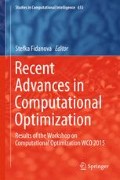Abstract
In this article we propose two effective methods to produce a near optimal solution for the problem of correlation clustering. We study their properties at different circumstances, and show that the inner structure generated by a tolerance relation has effect on the accuracy of the methods. Finally, we show that there is no royal road to the sequence of clusterings.
Access this chapter
Tax calculation will be finalised at checkout
Purchases are for personal use only
References
Aszalós, L., Bakó, M.: Advanced search methods (in Hungarian) (2012). http://morse.inf.unideb.hu/~aszalos/diak/fka
Aszalós, L., Mihálydeák, T.: Rough clustering generated by correlation clustering. Rough Sets, Fuzzy Sets, Data Mining, and Granular Computing, pp. 315–324. Springer, Berlin (2013). doi:10.1109/TKDE.2007.1061
Aszalós, L., Mihálydeák, T.: Rough classification based on correlation clustering. Rough Sets and Knowledge Technology, pp. 399–410. Springer, Berlin (2014). doi:10.1007/978-3-319-11740-9_37
Aszalós, L., Mihálydeák, T.: Correlation clustering by contraction. In: Ganzha, M., Maciaszek, L.A., Paprzycki, M. (eds.) Federated Conference on Computer Science and Information Systems, FedCSIS 2015, Lódz, Poland, 13–16 September 2015, pp. 425–434. IEEE (2015). doi:10.15439/2015F137
Aszalós, L., Mihálydeák, T.: Rough classification in incomplete databases by correlation clustering. In: Alonso, J.M., Bustince, H., Reformat, M. (eds.) Conference of the International Fuzzy Systems Association and the European Society for Fuzzy Logic and Technology (IFSA-EUSFLAT-15), Gijón, Spain, 30 June 2015. Atlantis Press (2015)
Aszalós, L., Kormos, J., Nagy, D.: Conjectures on phase transition at correlation clustering of random graphs. Ann. Univ. Sci. Bp. Sect. Comput. 42, 37–54 (2014)
Bansal, N., Blum, A., Chawla, S.: Correlation clustering. Mach. Learn. 56(1–3), 89–113 (2004). doi:10.1023/B:MACH.0000033116.57574.95
Bhattacharya, A., De, R.K.: Divisive correlation clustering algorithm (DCCA) for grouping of genes: detecting varying patterns in expression profiles. Bioinformatics 24(11), 1359–1366 (2008). doi:10.1093/bioinformatics/btn133
Chen, Z., Yang, S., Li, L., Xie, Z.: A clustering approximation mechanism based on data spatial correlation in wireless sensor networks. Wireless Telecommunications Symposium (WTS), pp. 1–7. IEEE (2010). doi:10.1109/WTS.2010.5479626
Dorigo, M., Gambardella, L.M.: Ant colonies for the travelling salesman problem. BioSystems 43(2), 73–81 (1997)
DuBois, T., Golbeck, J., Kleint, J., Srinivasan, A.: Improving recommendation accuracy by clustering social networks with trust. Recomm. Syst. Soc. Web 532, 1–8 (2009). doi:10.1145/2661829.2662085
Geem, Z.W.: Optimal cost design of water distribution networks using harmony search. Eng. Optim. 38(03), 259–277 (2006)
Kim, S., Nowozin, S., Kohli, P., Yoo, C.D.: Higher-order correlation clustering for image segmentation. In: Advances in Neural Information Processing Systems, pp. 1530–1538 (2011)
Néda, Z., Florian, R., Ravasz, M., Libál, A., Györgyi, G.: Phase transition in an optimal clusterization model. Phys. A: Stat. Mech. Appl. 362(2), 357–368 (2006). doi:10.1016/j.physa.2005.08.008
Néda, Z., Sumi, R., Ercsey-Ravasz, M., Varga, M., Molnár, B., Cseh, G.: Correlation clustering on networks. J. Phys. A: Math. Theor. 42(34), 345003 (2009)
Yang, B., Cheung, W.K., Liu, J.: Community mining from signed social networks. IEEE Trans. Knowl. Data Eng. 19(10), 1333–1348 (2007)
Zahn Jr., C.: Approximating symmetric relations by equivalence relations. J. Soc. Ind. Appl. Math. 12(4), 840–847 (1964). doi:10.1137/0112071
Author information
Authors and Affiliations
Corresponding author
Editor information
Editors and Affiliations
Rights and permissions
Copyright information
© 2016 Springer International Publishing Switzerland
About this chapter
Cite this chapter
Aszalós, L., Mihálydeák, T. (2016). Correlation Clustering by Contraction, a More Effective Method. In: Fidanova, S. (eds) Recent Advances in Computational Optimization. Studies in Computational Intelligence, vol 655. Springer, Cham. https://doi.org/10.1007/978-3-319-40132-4_6
Download citation
DOI: https://doi.org/10.1007/978-3-319-40132-4_6
Published:
Publisher Name: Springer, Cham
Print ISBN: 978-3-319-40131-7
Online ISBN: 978-3-319-40132-4
eBook Packages: EngineeringEngineering (R0)

